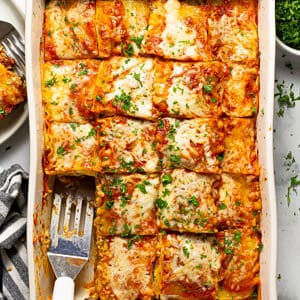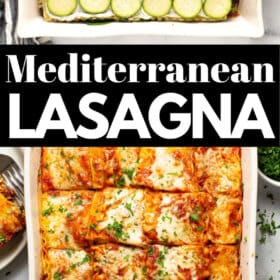Ingredients
- 16 lasagna noodles, cooked al dente
- 15 oz. whole milk ricotta cheese
- 1 egg
- 2 teaspoons dried oregano, divided
- 1 tablespoon olive oil
- 6 cloves garlic, thinly sliced
- 8 oz. feta cheese
- 6 tablespoons heavy cream
- 1 cup shredded Parmesan
- 24 oz. spaghetti sauce
- 8 oz. shredded mozzarella cheese (2 cups)
- 1 small zucchini, sliced about 1/4" thick
- 1/2 cup julienne-cut sun-dried tomatoes
- 2 cups fresh baby spinach leaves
- 12 oz. artichoke hearts, drained
- Kosher salt
- fresh cracked pepper
- fresh chopped parsley
Instructions
- Cook noodles according to package directions, just until al dente. Toss in olive oil and season with salt and pepper. Set aside to cool.
- Heat oven to 375 degrees.
- In a small bowl, combine ricotta, egg, 1 teaspoon oregano, and a couple large pinches of salt and pepper. Set aside.
- Heat olive oil in a large saute pan over medium-low heat. Add garlic and 1 teaspoon of oregano. Cook for 1 minute, stirring frequently.
- Add feta and heavy cream to the pan.
- Stir to combine and cook for 3-5 minutes or until the feta melts into a creamy sauce.
- Remove from heat and stir in 1/2 a cup of Parmesan until melted. Set aside.
- Spread 1/2 a cup of spaghetti sauce in the bottom of a 9×13 inch pan. Layer 4 noodles on top of the sauce, overlapping them slightly. Spread half the ricotta mixture in an even layer over the noodles.
- Then spread the spinach and artichoke hearts in an even layer.
- Add 1/2 a cup of shredded mozzarella cheese and drizzle 1/2 a cup of sauce over the mozzarella.
- Add 4 more noodles, overlapping them slightly.
- Spread all of the feta mixture in an even layer on top of the noodles. Add sun-dried tomatoes and add another 1/2 cup shredded mozzarella.
- Add 4 noodles, overlapping slightly. Then spread the remaining ricotta on top and arrange zucchini slices in a single layer.
- Add another 1/2 cup of shredded mozzarella. Then drizzle another 1/2 cup of sauce.
- Add the remaining 4 noodles, overlapping slightly.
- Add remaining sauce, spreading it in an even layer. Top with remaining mozzarella and add 1/2 a cup of shredded Parmesan.
- Cover tightly with tin foil and bake for 40 minutes. Remove foil and bake for another 10 minutes. Broil for 1-2 minutes.
- Let baked lasagna rest for 10 minutes. Garnish with fresh parsley and enjoy!
Notes
Use tongs to toss the cooked noodles and keep them separate. The noodles will try as hard as they can to stick together, which is why it’s important to toss them in oil right after they’ve cooked. Gently picking the noodles up with the tongs will ensure that they peel apart easily without breaking.
It may seem like there’s a lot of liquid in the pan after it bakes. But don’t worry – as it sits and cools, the liquid will be re-absorbed. Veggies release a lot of moisture as they cook. But the lasagna will soak it right up after it sits for 10 minutes.
To make lasagna ahead of time, assemble, cover with foil and refrigerate for up to 3 days before baking. Plan to add about 10-15 minutes of extra bake time when baking straight from the fridge.
To make ahead and freeze, transfer foil-covered lasagna to a large Ziploc bag and freeze for up to 3 months. If baking from frozen, plan to bake for 25-30 extra minutes.
You’ll know the lasagna is cooked through when the sauce/liquid in the pan around the edges is bubbling, and the cheese on top is melted. Also, you can try sticking a butterknife directly in the center of the lasagna all the way to the bottom of the pan. Remove the knife and carefully feel the blade of the knife to see if it is warm. If the center of your lasagna is warm, the blade of the knife will come out warm. If it is cold, your lasagna needs a bit longer.
- Prep Time: 25 minutes
- Cook Time: 50 minutes
- Category: Main Dish
- Method: Stove Top + Oven
- Cuisine: Italian
Nutrition
- Serving Size: 1 slice
- Calories: 287
- Sugar: 5.1 g
- Sodium: 488.4 mg
- Fat: 10.9 g
- Carbohydrates: 29.9 g
- Fiber: 4.5 g
- Protein: 16.2 g
- Cholesterol: 47.1 mg

